基于温度感知RFID标签的冷链厢体中温度监测
2017-11-17钱建平范蓓蕾杜晓伟孙立涛王以忠
钱建平,范蓓蕾,张 翔,杜晓伟,孙立涛,王以忠
基于温度感知RFID标签的冷链厢体中温度监测
钱建平1,2,范蓓蕾1,2,张 翔1,3,杜晓伟1,2,孙立涛1,3,王以忠3
(1. 北京农业信息技术研究中心,北京 100097;2.农产品质量安全追溯技术及应用国家工程实验室,北京 100097; 3.天津科技大学电子信息与自动化学院,天津 300222)
针对温度感知RFID(radio frequency identification)标签应用于冷链物流温度监测中缺乏有效数据验证的问题,该研究通过将42个温度感知RFID标签部署于冷链模拟平台中,划分了7个横截面、3个纵截面和两个层,设置了机械降温-冷链维持-自然回温3个不同阶段,同时在42个监测位点中选择7个位点同步部署了便携式温度记录仪,获取了不同条件下的温度监测数据,并与便携式温度记录仪数据和CFD(computational fluid dynamics)模拟数据进行了比较。7个温度感知RFID标签与便携式温度记录仪同步监测位点的数据表明,两种监测方法温差分布于±0.5℃范围内的数据点最多,占43.6%,温差分布于-1.0~-0.5 ℃区间的数据占了24.6%,考虑到2种设备自身的温度采集精度,温差在±0.8 ℃范围内可接的,其比例占71.3%,因此利用温度感知RFID标签进行冷链温度监测是可行的。对42个位点在3个不同阶段的温度监测数据表明,机械降温阶段各位点用时在1 h以内、冷链维持阶段大部分位点表现出温度在在0~4℃之间振荡的特征、自然回温阶段用时约49 h。深入分析机械降温阶段及冷链维持阶段不同截面的温度监测数据,结果表明3种截面均表现为降温初始阶段温度差值不稳定、稳定后具有明显的分布特征且离出风口较近降温较快的特点。以横截面2和横截面6平均温度为例,将温度感知RFID标签数据采集数据与CFD模拟数据进行比较,去除测量精度的干扰,截面2的均方根误差为0.73 ℃、平均相对误差为13.58%、截面6的均方根误差为0.56 ℃、平均相对误差为10.94%,具有较好的空间一致性。研究结果可为实现冷链物流中低成本、连续的温度监测奠定基础。
温度分布;监测;冷藏;冷链;RFID;CFD;感知标签
0 引 言
冷链物流是以冷冻工艺学为基础,以人工制冷技术为手段,以生产流通为衔接,为保证产品质量安全,减少因腐败变质引起的损耗,从而将易腐生鲜农产品在生产、贮藏、运输、销售乃至消费前的各环节始终处于规定的低温环境下的一项系统工程[1-3]。温度是冷链的核心,合理控制食品所需的低温环境,是降低损耗、维持品质、保障安全的关键[4-6]。
随着信息及通信技术的发展,对于冷链温度的监测已由单点向多点、有线向无线、延时向实时方向发展[7-10]。无线传感器网络(wireless sensor network,WSN)技术具有易于布置、方便控制、低功耗、灵活通信等特点[11-13];可为冷链过程温度的实时在线监测提供支撑[14-15]。Ruiz-Garcia等[16]将基于Zigbee的无线传感器网络应用于对水果温湿度实时监测;郭斌等[17]设计了集温湿度传感器、乙烯传感器于一体的无线传感节点,开发了果蔬冷链配送环境信息采集系统;齐林等[18]提出了基于统计过程控制(statistical process control,SPC)的感知数据压缩方法,用于解决农产品冷链物流中传感器节点的感知数据传输频率高、能耗高和监测时间短的问题。无线射频识别(radio frequency identification,RFID)是利用射频信号进行空间耦合实现非接触信息传递的自动识别技术[19-21];集成温度传感器的RFID感知标签是实现定时离线温度监测的有效方式[22]。Jedermann等[23]验证了温度感知RFID标签应用于冷藏车厢温度监控的可行性;Amador等[22]将RFID标签应用于商业运输中,实现了菠萝从哥斯达黎加的温度跟踪;汪庭满等[24]基于RFID实现了罗非鱼冷链物流温度监控系统。
虽然已有研究对温度感知RFID标签应用于冷链物流监测进行了初步应用分析,但是对于冷链不同阶段及冷链载体不同位置中RFID标签监测温度数据的变化过程还缺乏有效数据验证,从而限制了RFID标签的深入应用及监测精度的分析和提升。本研究通过将温度感知RFID标签部署于冷链模拟平台中,设置了机械降温-冷链维持-自然回温三个不同阶段,在验证利用温度感知RFID标签进行温度采集可行性的基础上,分析了温度的时空变化特点,为实现冷链物流中低成本、连续的温度监测奠定了基础。
1 材料与方法
1.1 温度监测设备
本研究中采用2种温度监测设备,分别为RFID温度感知标签(由北京昆仑海岸公司生产的JRFW-1-11型,温度测量范围为-20~+60 ℃、精度为±0.5 ℃,频率范围为13.56 MHz,内置锂电池供电,可持续工作1~3 a,价格较低。)、便携式温度记录仪(由艾普瑞(上海)精密光电有限公司生产的179-TH型,温度测量范围为-40~+100 ℃、精度±0.3 ℃,采用串口通信方式,非可充锂锰电池供电,可持续工作10 a,价格较高)。
1.2 试验厢体及设备部署
本文以北京市农林科学院小汤山基地冷链物流模拟平台为试验厢体,厢体壁面厚度为15 cm(由双面彩钢聚氨酯夹芯保温板组成,中间为聚氨酯库板),制冷机组下部固定有1个循环风机,直径约0.30 m;在距离厢体底面2 m高处配置有一层格栅板;厢体中部放置12箱苹果,均采用瓦楞纸箱包装,用于根据苹果自身呼吸热特性提供稳定的热源。
在该模拟厢体中,定义3种不同的虚拟截面,分别为7个横截面(cross section)T1、T2、T3、T4、T5、T6、T7、3个纵截面(longitudinal section)V1、V2、V3、两个层(layer)L1、L2。在每个截面的交叉点上部署RFID温度感知标签,共计42个监测点。同时,为了验证温度传感RFID标签监测温度的有效性,在L1层选择3个点位、L2层选择4个点位,共7个点位同时部署便携式温度记录仪,冷链模拟平台厢体结构、截面划分及温度监测位置如图1所示。
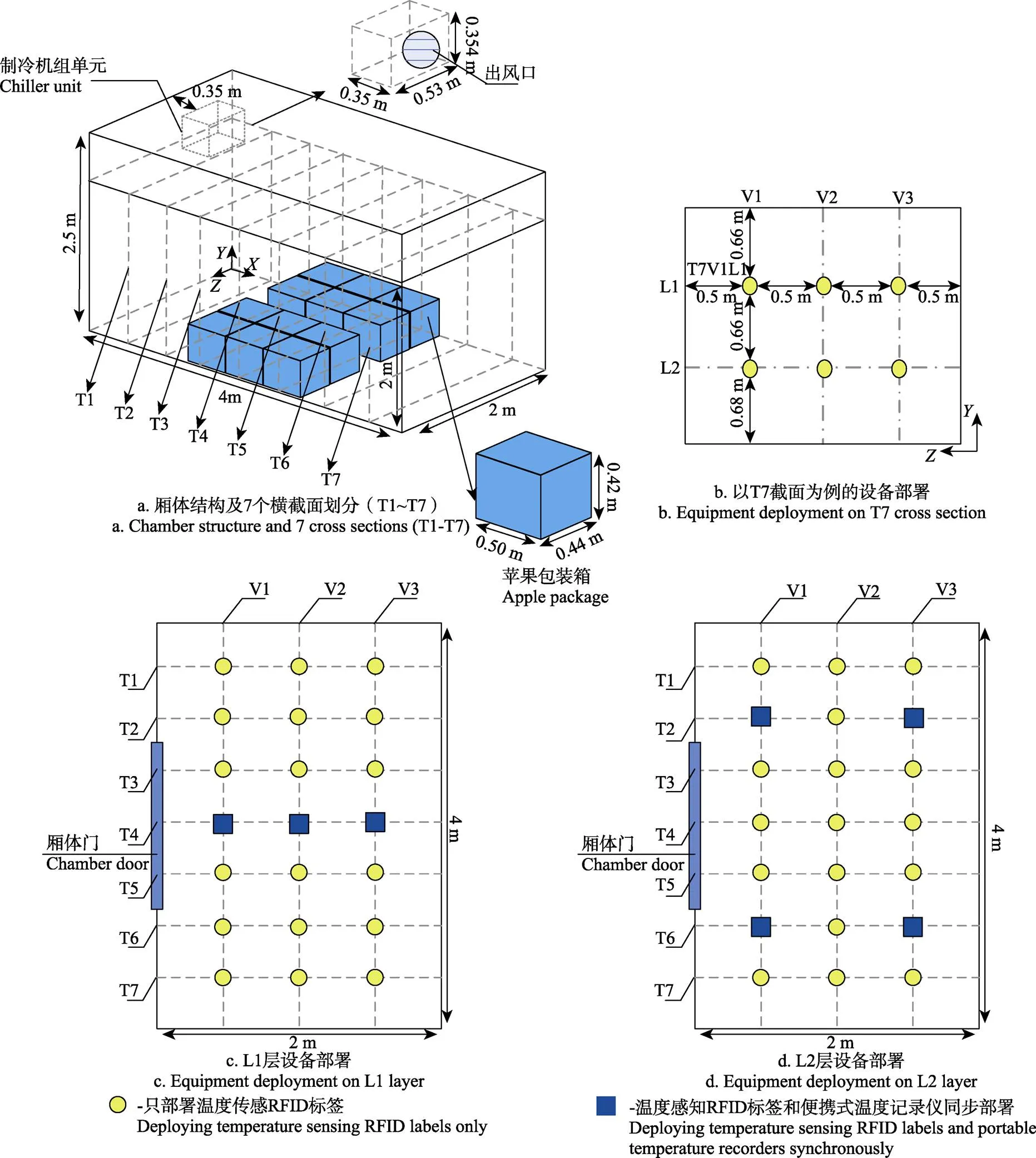
图1 试验冷链厢体及温度传感设备部署示意图
1.3 试验方法
试验于2016年12月7日14:00—10日11:00进行,持续69 h。采用机械降温-冷链维持-自然回温的方式,具体过程为:1)12月7日14:00启动制冷机组进行降温,制冷机组设置为自动启停,启停阈值设置为0~4 ℃,即温度高于4 ℃制冷机组启动、温度低于0℃制冷机组停止;此过程的前段从室温降到温度阈值区间为机械降温阶段,后段在阈值区间波动时为冷链维持阶段;2)12月8日10:00关闭制冷机组,使其自然回温。
整个过程采用温度感知RFID标签和便携式温度记录仪进行温度自动采集,采集时间间隔为4 min,在监测结束后将数据读出。
1.4 数据分析
数据统计分析利用Microsoft Excel2010软件;采用有限元体积法的CFD商用软件Fluent进行计算,利用Gambit建立三维实体模型,计算时采用SST(shear stress transport)方程模型,基于压力的分离式求解器,动量、能量、湍动能、扩散率的离散格式为一阶迎风格式,压力速度耦合方法采用SIMPLE(semi-implicit method for pressure-linked equations)算法;对于苹果热源的加载,利用苹果呼吸热模型计算苹果呼吸热参数,通过Fluent中加载UDF(user-defined function)的方式将呼吸热参数化来实现。
利用上述方法,本研究的数据分析过程如下:1)比较7个同步采集点的数据,验证温度感知RFID标签用于冷链温度监测的可行性;2)分析42个RFID采集点的数据,探究厢体内温度时空变化特征;3)选取两个截面进行CFD模拟,每个截面选择6个点比较CFD模拟值与RFID测试值,进一步分析验证空间变化特点。
2 结果分析
2.1 便携式温度记录仪数据与温度感知RFID标签数据的比较
以冷链维持阶段(12月7日15:00-12月8日10:00)为基础,以每隔20 min取一次数据进行比较,共58组、7个点位共406条数据;为了更直观的分析温度感知RFID标签数据与便携式温度记录仪数据的差异,以精度较高的便携式温度记录仪数据为参考,分析7个点位(T4V1L1、T4V2L1、T4V3L1、T2V1L2、T2V3L2、T6V1L2、T6V3L2)的两者温度差值,如图2所示。
由图2可见,7个点位中的两种不同监测方式存在着一定的温度差值,其中温差分布于±0.5 ℃范围内的数据点最多,为177条,占43.6%、温差分布于-1.0~-0.5 ℃区间的数据为100条,占24.6%,温度差分布于0.5~1.0 ℃的数据为36条。由于温度传感RFID标签和便携式温度记录仪自身的温度测量精度分别为±0.5 ℃和±0.3 ℃,因此温差在±0.8℃范围内是可接受的;而在406条数据中,其比例占71.3%,因此用温度传感RFID标签进行冷链监测是可行的。另一方面,温度差为负值的数据占了74.6%,远高于温度差为正值的数据量,这可能与RFID标签中的温度传感器被封装在塑料外壳内,导致采集不敏感有关。

图2 7个点位温度感知RFID标签数据与便携式温度记录仪数据的温度差值分布
2.2 全过程温度变化分析
在厢体内共部署42个温度感知RFID标签采集点,每个点采集到1 035条数据,共采集到RFID标签数据 43 470条。对这些数据按3个纵截面、7个横截面、2个层分别取平均值,得到各不同截面在整个过程中的温度变化如图3所示。
由图3可见,3种不同截面的数据均表现出从室温(约21 ℃)到设定的阈值温度,呈现快速下降的趋势,这个过程42个采集点都在1 h以内;而冷链维持阶段(约从12月7日15:00到12月8日10:00关闭制冷风机)大部分表现为在0~4 ℃之间振荡的特征,这是因为制冷机组设置为在0~4 ℃范围内自动启停;在关闭风机后的自然升温阶段,3种不同截面数据均表现为缓慢上升的趋势,回到接近室温(20.5±0.5 ℃)约49 h。
2.3 机械降温及冷链维持阶段不同截面温度比较
由于实际应用中更注重降温过程及冷链维持状况,而对回温阶段关注不多,为了更直观地了解不同截面之间的温度差异,以机械降温和冷链维持阶段(12月7日14:00-12月8日10:00)为基础比较不同截面的温度分布特点,以该截面采集点的平均温度作为截面的温度值。由于每隔4 min采集一次数据,其变化并不明显,为了增强数据的直观性,以每隔20 min取一次数据进行比较,每组共61个数据。纵截面以V2为基准值,分析V1、V3与V2的差值;横截面以T4为基准值,分析T1、T2、T3、T5、T6、T7与T4的差值;上下层面以L2为基准值,计算L1与其差值。结果如图4所示。
由图4可见,3种截面图均表现为降温初始阶段温度差值不稳定的特点,这可能是由初始阶段温度场不均匀,冷暖气流在一定空间内交替扰动形成的;在温度稳定后,3种截面图均表现为明显的分布特征。对于纵截面, V1-V2和V3-V2大部分为负值,这表明V2截面的温度小于V1和V3,这是由于出风口位于中部,导致位于中部V2纵截面降温较快。对于横截面,除了T2-T4外,大部分差值为正值,这与T2横截面位于出风口下方有很大关系;与除T2外的其他截面相比,T7也表现出部分向负值靠近的趋势,这可能与T7横截面位于厢体尾部,部分冷气流遇到阻挡后回流有关。对于上下层面,L1-L2大部分为负值,这也符合离出风口较近而降温较快的特点。

图3 不同截面温度变化
2.4 利用CFD模拟值比较截面上温度的分布特征
为了进一步分析温度传感RFID标签采集到的数据在横截面上的分布特点,选取T2和T6截面,参考韩佳伟等[25]方法利用CFD进行温度场模拟,冷链维持阶段的模拟结果如图5所示。
采用均方根误差(root-mean-square-error,RMSE)和平均相对误差(average-relative-deviation,ARD)判定试验值与模拟值之间的关系。.

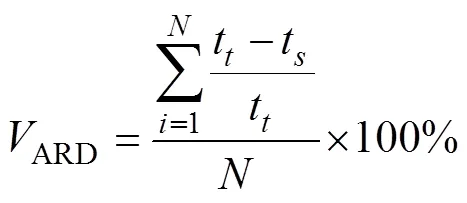
式中t为试验值,℃,t为模拟值,℃,为样本点 数量。
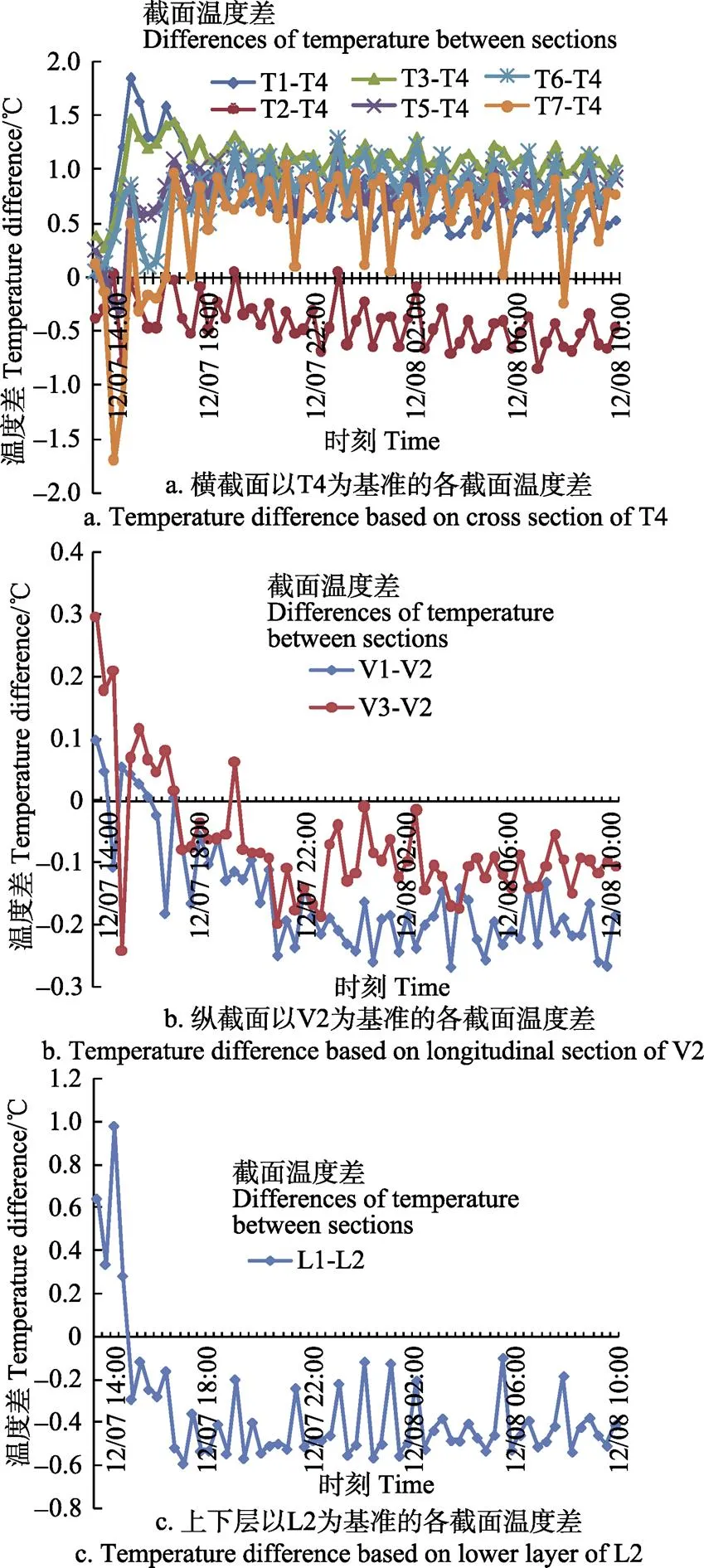
图4 不同截面温度差比较
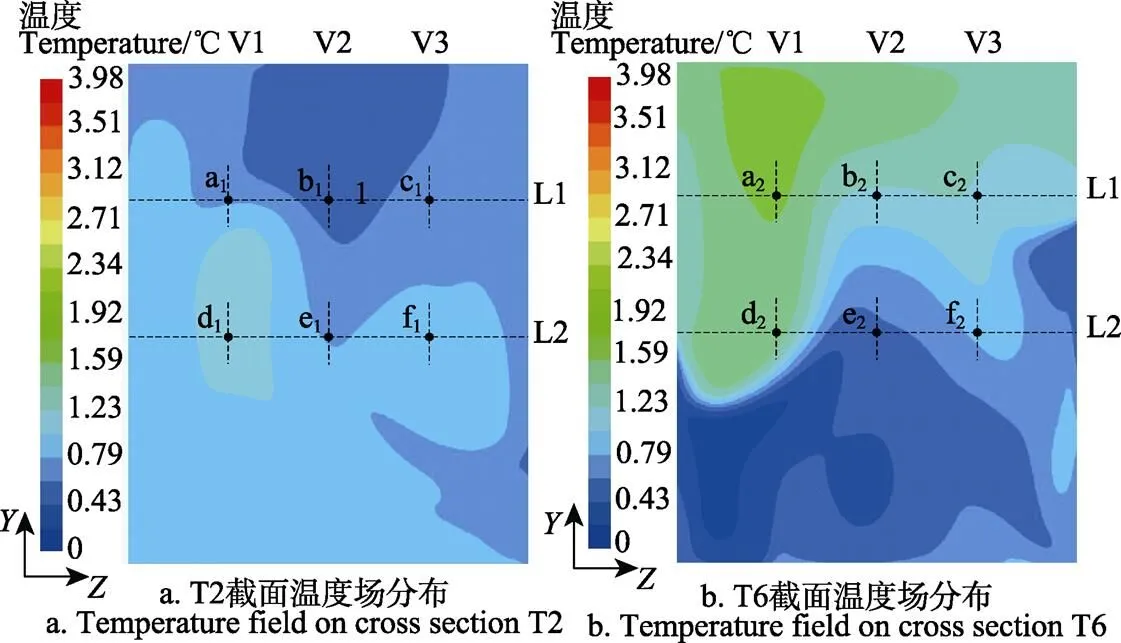
图5 冷链维持阶段12月7日15:16,截面T2、T6温度场分布
由图6可以看出,冷链维持阶段T2、T6截面平均温度CFD模拟值与RFID实测值大部分吻合较好,利用公式(1)、(2)计算试验值与模拟值间的误差,得到截面2的均方根误差为1.97 ℃,平均相对误差为20.67%;截面6的均方根误差为1.68 ℃,平均相对误差为18.29%;考虑到温度传感RFID标签自身的温度测量精度为±0.5 ℃,去除测量精度的干扰,截面2的均方根误差为0.73 ℃,平均相对误差为13.58%;截面6的均方根误差为0.56 ℃,平均相对误差为10.94%,表明实测值与模拟值吻合度较好;但也存在个别数据点出现偏差过大的情况,其原因还需进一步通过验证。
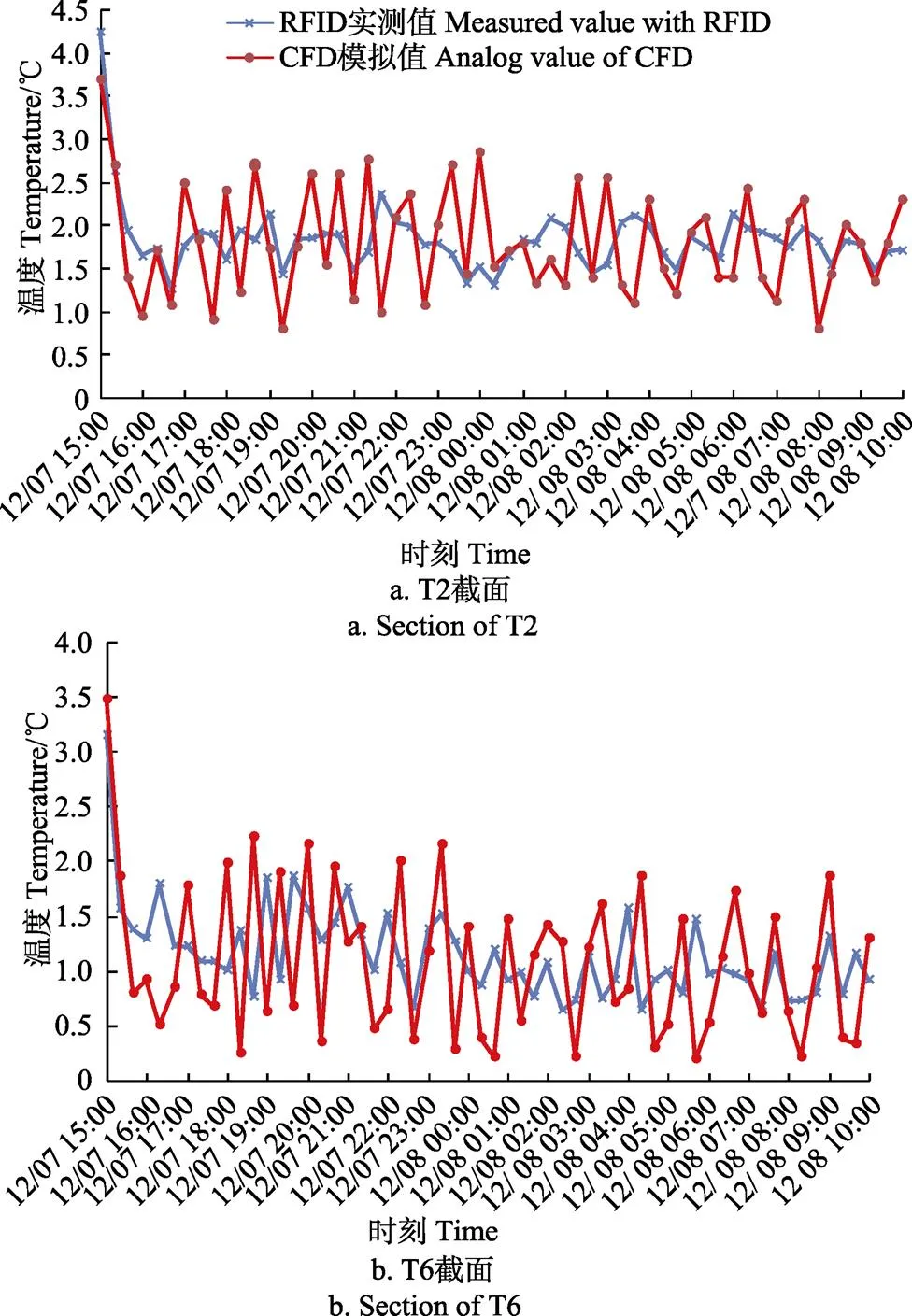
图6 冷链维持阶段,T2、T6截面平均温度CFD模拟值与 RFID实测值对比
3 结 论
通过将温度感知RFID(radio frequency identification)标签部署于冷链模拟平台中,设置了机械降温-冷链维持-自然回温3个不同阶段,划分横截面、纵截面和上下层3种虚拟面,分析了封闭厢体内的温度时空变化特点,并与便携式温度记录仪采集数据进行了比较分析,两种监测方法温差分布于±0.5 ℃范围内的数据点最多,占43.6%,温差分布于-1.0~-0.5 ℃区间的数据占了24.6%,考虑到两种设备自身的温度采集精度,温差在±0.8 ℃范围内是可接受的,其比例占71.3%,结果表明利用温度感知RFID标签进行冷链温度监测是可行的。
通过对42个位点在3个不同阶段的温度监测数据表明,机械降温阶段42个位点从室温(约21 ℃)到设定的阈值温度用时均在1h以内、冷链维持阶段大部分位点表现出温度在0~4 ℃之间振荡的特征、自然回温阶段用时约49 h。以T2和T6截面平均温度为例,将温度感知RFID标签数据采集数据与CFD模拟数据进行比较,去除测量精度的干扰,截面2的均方根误差为0.73 ℃,平均相对误差为13.58%;截面6的均方根误差为0.56 ℃,平均相对误差为10.94%。
温度传感RFID标签虽然提供了一种低成本、易部署的温度采集方式,但由于其采集精度还需提升,后期研究可通过改进标签的封装设计或利用高精度传感器进行校准,以更好应用于冷链的全程温度跟踪。
[1] 杨胜平,谢晶,高志立,等. 冷链物流过程中温度和时间对冰鲜带鱼品质的影响[J]. 农业工程学报,2013,29(24):302-310. Yang Shengping, Xie Jing, Gao Zhili, et al. Effect of temperature and time fluctuations on quality changes of iced Trichiurus haumela in cold chain logistics process[J]. Transactions of the Chinese Society of Agricultural Engineering (Transactions of the CSAE), 2013, 29(24): 302-310. (in Chinese with English abstract)
[2] Xiao Xinqing, He Qile, Li Zhigang, et al. Improving traceability and transparency of table grapes cold chain logistics by integrating WSN and correlation analysis[J]. Food Control, 2017,73: 1556-1563.
[3] 申江,杨萌. 食品冷链的技术发展[J]. 包装工程,2015,36(15):1-7. Shen Jiang, Yang Meng. Technological development of food cold chain[J]. Package Engineering, 2015, 36(15): 1-7. (in Chinese with English abstract)
[4] 刘璐,岳峻,张健,等. 水产品冷链管理决策模型的构建[J]. 农业工程学报,2010,26(8):379-385. Liu Lu, Yue Jun, Zhang Jian, et al. Construction of cold chain decision support system for aquatic products[J]. Transactions of the Chinese Society of Agricultural Engineering (Transactions of the CSAE), 2010, 26(8): 379-385.(in Chinese with English abstract)
[5] 赵春江,韩佳伟,杨信廷,等. 冷链物流研究中的计算流体力学数值模拟技术[J]. 农业机械学报,2015,46(3): 214-222. Zhao Chunjiang, Han Jiawei, Yang Xinting, et al. Digital simulation technology of computational fluid dynamics in agricultural cold-chain logistics Applications[J]. Transactions of the Chinese Society for Agricultural Machinery, 2015,46(3): 214-222. (in Chinese with English abstract)
[6] Badia-Melis R, Qian J P, Fan B L, et al. Artificial neural networks and thermal image for temperature prediction in apples[J]. Food and Bioprocess Technology, 2016, 9(3): 1-11.
[7] Aung Myo Min, Chang Yoon Seok. Temperature management for the quality assurance of a perishable food supply chain[J]. Food Control, 2014, 40: 198-207.
[8] 杨信廷,钱建平,孙传恒,等. 农产品及食品质量安全追溯系统关键技术研究进展[J]. 农业机械学报,2014,45(11):212-222. Yang Xinting, Qian Jianping, Sun Chuanheng, et al. Key technologies for establishment agricultural products and food quality safety traceability systems[J]. Transactions of the Chinese Society for Agricultural Machinery, 2014, 45(11): 212-222. (in Chinese with English abstract)
[9] Lehmann Richard J, Reiche Robert, Schiefer Gerhard. Future internet and the agri-food sector: State-of-the-art in literature and research[J]. Computers and Electronics in Agriculture, 2012, 89: 158-174.
[10] Wang Lixing, Kwok S K, Ip W H. A radio frequency identification and sensor-based system for the transportation of food[J]. Journal of Food Engineering, 2010, 101(1): 120-129.
[11] Wang Ning, Zhang Naiqian, Wang Maohua. Wireless sensors in agriculture and food industry: Recent development and future perspective[J]. Computers and Electronics in Agriculture, 2006, 50(1): 1-14.
[12] Qian Jianping, Yang Xinting, Wu Xiaoming, et al. Farm and environment information bidirectional acquisition system with individual tree identification using smartphones for orchard precision management[J]. Computers and Electronics in Agriculture, 2015, 116: 101-108.
[13] Steinberger Georg, Rothmund Matthias, Auernhammer Hermann. Mobile farm equipment as a data source in an agricultural service architecture[J]. Computers and Electronics in Agriculture, 2009, 65(2): 238-246.
[14] 汪旭晖,张其林. 基于物联网的生鲜农产品冷链物流体系构建:框架、机理与路径[J]. 南京农业大学学报:社会科学版,2016,16(1):31-41. Wang Xuhui, Zhang Qilin. Construction of cold-chain logistics system for fresh agricultural products based on the internet of things: Framework, mechanism and path[J]. Journal of Nanjing Agricultural University: Social Sciences Edition, 2016, 16(1): 31-41. (in Chinese with English abstract)
[15] Wang X, He Q, Matetic M, et al. Development and evaluation on a wireless multi-gas-sensors system for improving traceability and transparency of table grape cold chain[J]. Computers and Electronics in Agriculture, 2017(135): 175-207.
[16] Ruiz-Garcia L, Barreiro P, Robla J. Performance of ZigBee-based wireless sensor nodes for real-time monitoring of fruit logistics[J]. Journal of Food Engineering, 2008(87): 405-415.
[17] 郭斌,钱建平,张太红,等. 基于Zigbee的果蔬冷链配送环境信息采集系统[J]. 农业工程学报,2011,27(6):208-213. Guo Bin, Qian Jianping, Zhang Taihong, et al. Zigbee-based information collection system for the environment of cold-chain logistics of fruits and vegetables[J]. Transactions of the Chinese Society of Agricultural Engineering (Transactions of the CSAE), 2011, 27(6): 208-213. (in Chinese with English abstract)
[18] 齐林,韩玉冰,张小栓,等. 基于WSN的水产品冷链物流实时监测系统[J]. 农业机械学报,2012,43(8):134-140. Qi Lin, Han Yubing, Zhang Xiaoshuan, et al. Real time monitoring system for aquatic cold-chain logistics based on WSN[J]. Transactions of the Chinese Society for Agricultural Machinery, 2012, 43(8): 134-140. (in Chinese with English abstract)
[19] 钱建平,杨信廷,张保岩,等. 基于RFID的蔬菜产地追溯精确度提高方案及应用[J]. 农业工程学报,2012,28(15):234-239. Qian Jianping, Yang Xinting, Zhang Baoyan, et al. RFID-based solution for improving vegetable producing area traceability precision and its application[J]. Transactions of the Chinese Society of Agricultural Engineering (Transactions of the CSAE), 2012, 28(15): 234-239. (in Chinese with English abstract)
[20] Luvisi Andrea, Panattoni Alessandra, Bandinelli Roberto, et al. Ultra-high frequency transponders in grapevine: A tool for traceability of plants and treatments in viticulture[J]. Biosystems Engineering, 2012, 113(2): 129-139.
[21] Qian Jianping, Yang Xinting, Wu Xiaoming, et al. A traceability system incorporating 2D barcode and RFID technology for wheat flour mills[J]. Computers and Electronics in Agriculture, 2012, 89(3): 76-85.
[22] Amador C, Émond J P, Nunes M C N. Application of RFID technologies in the temperature mapping of the pineapple supply chain[J]. Sensing and Instrumentation for Food Quality and Safety, 2009, 3(1): 26-33
[23] Jedermann Reiner, Ruiz-Garcia Luis, Lang Walter. Spatial temperature profiling by semi-passive RFID loggers for perishable food transportation[J]. Computers and Electronics in Agriculture, 2009, 65(2): 145-154.
[24] 汪庭满,张小栓,陈炜,等. 基于无线射频识别技术的罗非鱼冷链物流温度监控系统[J]. 农业工程学报,2011,27(9):141-146. Wang Tingman, Zhang Xiaoshuan, Chen Wei, et al. RFID-based temperature monitoring system of frozen and chilled tilapia in cold chain logistics[J]. Transactions of the Chinese Society of Agricultural Engineering (Transactions of the CSAE), 2011, 27(9): 141-146. (in Chinese with English abstract)
[25] 韩佳伟,赵春江,杨信廷,等. 基于CFD数值模拟的冷藏车节能组合方式比较[J]. 农业工程学报,2013,29(19):55-62.Han Jiawei, Zhao Chunjiang, Yang Xinting, et al. Comparison of combination mode of energy conservation for refrigerated car based on CFD numerical simulation[J]. Transactions of the Chinese Society of Agricultural Engineering (Transactions of the CSAE), 2013, 29(19): 55-62. (in Chinese with English abstract)
钱建平,范蓓蕾,张 翔,杜晓伟,孙立涛,王以忠.基于温度感知RFID标签的冷链厢体中温度监测[J]. 农业工程学报,2017,33(21):282-288. doi:10.11975/j.issn.1002-6819.2017.21.035 http://www.tcsae.org
Qian Jianping, Fan Beilei, Zhang Xiang, Du Xiaowei, Sun Litao, Wang Yizhong.Temperature monitoring in cold chain chamber based on temperature sensing RFID labels[J]. Transactions of the Chinese Society of Agricultural Engineering (Transactions of the CSAE), 2017, 33(21): 282-288. (in Chinese with English abstract) doi:10.11975/j.issn.1002-6819.2017.21.035 http://www.tcsae.org
Temperature monitoring in cold chain chamber based on temperature sensing RFID labels
Qian Jianping1,2, Fan Beilei1,2, Zhang Xiang1,3, Du Xiaowei1,2, Sun Litao1,3, Wang Yizhong3
(1.,100097,; 2.,100097,; 3.,,300222,)
Temperature is the core of cold chain and its monitoring plays a fundamental role on controlling temperature and reducing energy consumption comfortably. With the development of information and communication technology, the monitoring of cold chain temperature has been developed from single point to multipoint, from wired to wireless, and from delayed to real-time. Compared with the temperature monitoring based on WSN (wireless sensor network), the temperature monitoring based on RFID (radio frequency identification) has the characteristics of low cost, low energy consumption and high flexibility. For the problem of lack of effective data validation with RFID temperature tags applied in the processing of cold chain logistics temperature monitoring, a cold chain simulation chamber was used for this study. The chamber’s wall thickness is 15 cm and the refrigeration unit is fixed at the lower part of a circulating fan with a diameter of about 0.30 m. Twelve boxes of apples were placed in the middle of the chamber to provide a stable source of respiratory heat. Temperature monitoring experiment was designed through deploying 42 temperature sensing RFID tags in the chamber. The chamber space was divided into 3 types of virtual sections, i.e. 7 cross surfaces, 3 longitudinal sections and 2 layers. The experiment was lasting for 69 h from 14:00 on December 7 to 11:00 on December 10 in 2016. It was split into 3 stages according to the temperature's diversification, which were mechanical cooling, cold chain keeping and temperature recovering. Simultaneously, 7 portable temperature recorders were deployed in the sites selected from 42 temperature sensing RFID tags points to record the temperature, and the difference between the 2 temperature monitoring methods was compared. In addition, temperature spatial simulation data with CFD (Computational Fluid Dynamics) were compared with the temperature sensing RFID tag data to analyze spatial difference. The recording interval was 4 min. Characteristics of temporal and spatial variation were analyzed through the experiment and using Microsoft Excel 2010 software, CFD simulation software and Fluent 15.0 solver. At each point 1 035 data were collected, and 43 470 RFID tags data for 42 points were collected in the experiment. Seven synchronous data from portable temperature recorders and temperature sensing RFID tags showed that temperature difference between the 2 temperature monitoring methods in the range from-1.0 to-0.5 ℃ and from-0.5 to +0.5 ℃ accounted for 24.6% and 43.6% respectively. The result indicates that it is feasible to use RFID tags for temperature monitoring in cold chain processing. Further, temperature monitoring data from 42 RFID tags in the 3 different stages showed that, time consumption in the mechanical cooling stage was less than 1 h, temperature fluctuation in the cold chain keeping stage between 0 to 4 ℃ was obvious, and time consumption in the temperature recovering stage was about 49 h. Through deeper analysis on the temperature monitoring data of different virtual sections from the mechanical cooling stage and the cold chain keeping stage, the result showed that temperature difference in the initial cooling stage was unstable and spatial distribution in the temperature calm stage was significant. Specially, the feature that the site nearer to the outlet had faster cooling was evident. Taking the average temperature of T2 (No.2 cross surface) and T6 (No.6 cross surface) as an example, the data acquired by temperature sensing RFID tag were compared with CFD simulation data. Except for the interference of measurement precision, RMSE (root-mean-square-error) and ARD (average-relative-deviation) of T2 were 0.73 ℃ and 13.58%. RMSE and ARD of T6 were 0.56℃ and 10.94%. Spatial consistency was verified. The research result can provide the reference for achieving low cost and continuous temperature monitoring in cold chain logistics. The follow-up studies can be enhanced by improving package design label or the use of high precision sensor, with better application in the whole cold chain of tracking.
temperature distribution; monitoring; cold storage; cold chain; radio frequency identification; computational fluid dynamics; sensing label
10.11975/j.issn.1002-6819.2017.21.035
TS255.3
A
1002-6819(2017)-21-0282-07
2017-04-22
2017-09-15
国家重点研发计划项目-食品供应链质量控制与管理系统研发(2016YFD0401205);北京市农林科学院2017年度科研创新平台建设(KYCXPT201723)
钱建平,男,浙江湖州人,副研究员,主要从事农产品质量安全追溯技术研究。Email:qianjp@nercita.org.cn
中国农业工程学会会员:钱建平(E041200542S)
